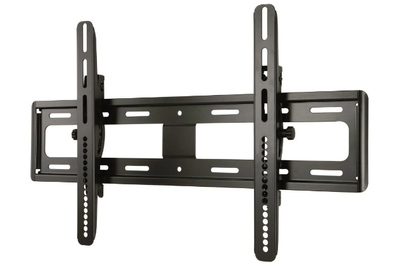No matter how you watch TV—in bed, on the couch, in a chair, standing up while making dinner—“you really just want to be able to look straight out of your eyes and have them be in the middle of the screen,” Erickson advises.
Finding the right height for your TV can be as simple as taking a tape measure and checking that the distance from the floor to the middle of your screen roughly equals the distance from the floor to your eyes in whatever your most frequent viewing position is. Note that, when viewing the TV, your head should be in a neutral position with your shoulders down, your neck straight, and your chin neither tilted down nor jutting up.

How to fix this: To adjust the height of your TV without completely reconfiguring your room, you have a few options. If your TV is mounted too high but you can’t or don’t want to relocate it, a tilting mount—such as our top pick, the Sanus VMPL50A-B1—allows you to angle the screen downward and watch more comfortably, even though the TV is still, technically, too damn high.
“The goal is to sit with your head erect and shoulders back, looking straight ahead to the screen,” Erickson explains. “Using a slanted mount protects you from extending your head and neck backwards and lifting your chin to see a screen that is too high.”
Top pick
However, it’s ideal to actually lower the screen rather than just tilt it. If you can spend a little more, look for pull-down or drop-down mounts that move straight down so that the screen needn’t be tilted (although such mounts usually let you tilt it as well, if you want). For TVs that are mounted above a mantel, which prevents them from moving straight down, these mounts typically come with an extending feature that allows the set to come out in front of the mantel before lowering.
“If you spend a lot of hours watching TV, which most people do, having a drop mount makes a huge difference,” Erickson says.

Wirecutter has not tested or reviewed these types of mounts, but senior staff writer Doug Mahoney, who wrote our TV wall mount guide, says to look for models that are UL certified for safety, such as the MantelMount MM340 Standard Pull Down TV Mount, which can accommodate 44- to 80-inch TVs that weigh up to 90 pounds.
If your TV sits on a media stand or other piece of furniture, anchoring it to an adjustable TV pedestal that stands on the same surface is an affordable and easy way to change its height.
Several months ago, senior updates writer Ivy Liscomb, a member of our PC and networking team, purchased an Onn tabletop TV stand (which can hold 37- to 70-inch TVs that weigh up to 110 pounds), and has been very pleased with its performance. “It works beautifully, was easy to install, and also created some storage under the TV that was not available with the TV’s stock legs,” she says. (We’ve previously recommended other Onn products, including the Onn Google TV 4K Pro media streamer and a 43-inch Onn 4K Roku TV.)
Editor Signe Brewster also likes the Perelsmith Swivel Universal TV Stand, which she has used since 2020. It is designed to accommodate 43- to 60-inch LCD/LED TVs.





